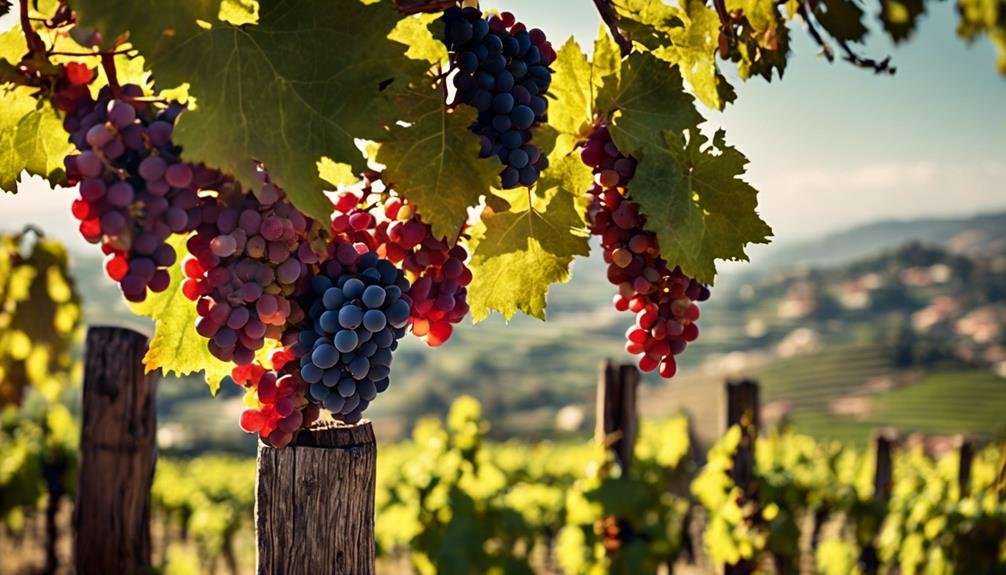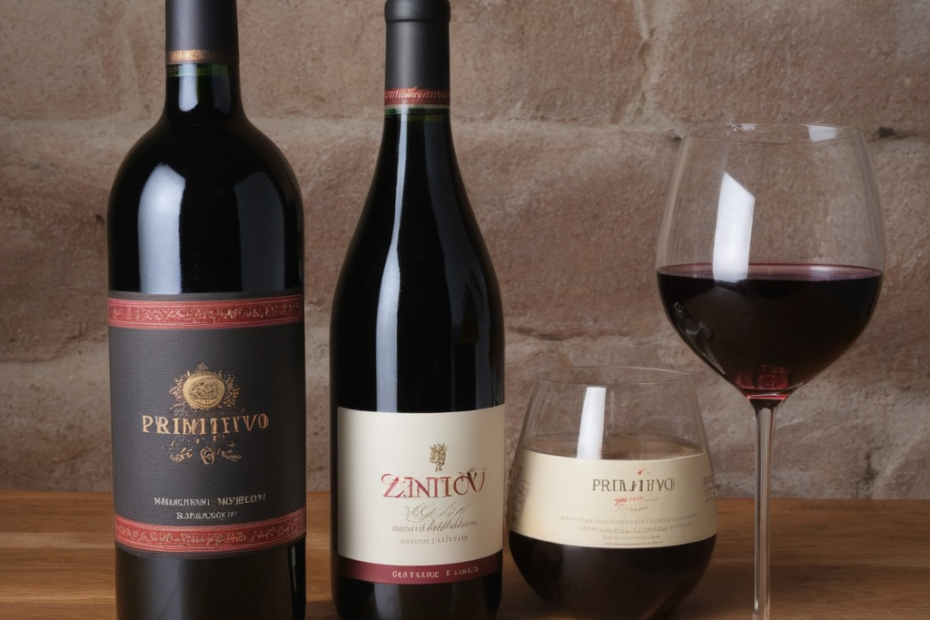In the Primitivo vs. Zinfandel wine tasting showdown, Italian Primitivo and Californian Zinfandel offer distinct experiences. Primitivo, with its dark fruit flavors, high alcohol, and mild tannins, contrasts with Zinfandel's fruitier, sweeter profile. Influenced by terroir, Primitivo showcases spiciness and supple fruit, while Zinfandel boasts pronounced fruity aromas. The geographical diversity shapes their flavor profiles; from robust dark fruit in Primitivo to sweet fruitiness in Zinfandel. Food pairing enhances the experience: Primitivo excels with spiced dishes, while Zinfandel complements sweet or spicy foods. The verdict? Choose based on your preference for bold spices or fruity sweetness.
Origins and Shared Heritage
How did Italian Primitivo and Zinfandel from California come to share a common heritage despite originating from the same grape variety in Croatia?
The grape lineage of both Italian Primitivo and Californian Zinfandel can be traced back to the Croatian grape called Tribidrag. Despite this shared origin, regional differences have led to distinct characteristics in the wines produced.
Italian Primitivo, particularly from the region of Puglia, is known for its dark fruit flavors, high alcohol content, low acidity, and mild tannins. On the other hand, Zinfandel from California tends to be fruitier and sweeter.
These regional variations are influenced by factors such as terroir, climate, and winemaking techniques, highlighting the diverse expressions of this grape variety across different regions.
Tasting Notes and Comparisons
Tasting notes and comparisons reveal the nuanced differences between Italian Primitivo and Californian Zinfandel, stemming from their shared grape heritage originating in Croatia. Primitivo is noted for its dark fruit flavors, high alcohol content, low acidity, and mild tannins, while Zinfandel tends to be sweeter and fruitier. When comparing aroma profiles, Primitivo often exhibits hints of spice and supple fruit, whereas Zinfandel leans towards more pronounced fruity notes. To illustrate the distinctions further, refer to the table below:
| Primitivo | Zinfandel | |
|---|---|---|
| Flavor | Dark fruit, spice, supple fruit | Sweet, fruity |
| Aroma | Spicy, fruity | Pronounced fruity notes |
This table succinctly captures the key flavor nuances and aroma profiles that set these two wines apart.
Terroir Influence on Flavor Profiles

The geographical diversity of vineyards greatly influences the distinct flavor profiles of Italian Primitivo and Californian Zinfandel wines. Climate variations and soil composition play crucial roles in shaping these wines.
Italian Primitivo thrives in the warm, arid climate of Puglia, resulting in wines with robust dark fruit flavors, high alcohol content, and mild tannins. On the other hand, Californian Zinfandel, particularly from regions like Lodi with hot daytime temperatures, tends to be sweeter and fruitier due to the climate differences.
The soil composition in each region further impacts the grapes' characteristics, with Italian Primitivo from Salento benefiting from coastal winds and unique soil types, enhancing its spiciness and supple fruit notes. Understanding these terroir influences can deepen appreciation for the diverse flavor profiles of Primitivo and Zinfandel wines.
Food Pairing Recommendations
Food pairings can greatly enhance the tasting experience of Italian Primitivo and Californian Zinfandel wines by complementing their distinct flavor profiles. When considering culinary pairings, preferences play an essential role.
Italian Primitivo, with its dark fruit, spiciness, and supple fruit flavors, pairs beautifully with dishes like pulled pork and eggplant parmesan. The rich and bold flavors of Primitivo are well-suited to hearty and flavorful foods that can stand up to its intensity.
On the other hand, Californian Zinfandel, known for its sweetness and fruitiness, can be matched with dishes that have a touch of sweetness or a hint of spice. Exploring different food pairings can elevate the tasting experiences of both wines, creating memorable culinary experiences.
Final Verdict and Recommendations

Considering the distinctive flavor profiles of Italian Primitivo and Californian Zinfandel wines, it is imperative to explore the final verdict and recommendations to fully appreciate their nuances.
In the verdict comparison, Italian Primitivo showcases dark fruit, spiciness, and supple fruit flavors, while Californian Zinfandel leans towards sweetness and fruitiness. Ultimately, the flavor preference boils down to personal taste.
If you enjoy bold, spicy wines with a touch of fruitiness, Primitivo might be your choice. On the other hand, if you prefer sweeter, fruit-forward wines, Zinfandel could be more to your liking.
Both wines offer unique characteristics worth exploring, so trying both and deciding based on your palate preferences is recommended.
Frequently Asked Questions
Are There Significant Differences in Winemaking Techniques Between Primitivo and Zinfandel?
When comparing Primitivo and Zinfandel, differences in winemaking techniques are evident in the fermentation process. Primitivo, known for its dark fruit and spiciness, may be crafted using varying methods compared to Zinfandel, which often showcases a fruitier profile.
How Does the Aging Process Affect the Flavor Profiles of Primitivo and Zinfandel?
The aging process greatly impacts the flavor profiles of Primitivo and Zinfandel. Through aging, these wines undergo sensory exploration, developing nuances of dried fruits, spices, and earthy notes. This transformation enhances complexity and depth, elevating the overall drinking experience.
What Are the Key Factors That Contribute to the Spiciness in Primitivo Wines?
The spiciness in Primitivo wines derives from a combination of factors, including the grape varietal's genetic makeup, terroir influences such as soil composition and climate, and the winemaking techniques employed, all contributing to its distinctive flavor profile.
Can Primitivo and Zinfandel Wines Be Successfully Blended Together?
Blending potential between Primitivo and Zinfandel wines is viable due to their shared origins. However, differences in flavor profiles, with Primitivo leaning towards spiciness and Zinfandel towards fruitiness, must be carefully balanced to create a harmonious and complex blend.
Are There Specific Regions Outside of Italy and California Where Primitivo and Zinfandel Thrive?
Primitivo and Zinfandel thrive not only in Italy and California but also in regions like Argentina and Australia. These areas offer diverse terroirs that contribute unique characteristics to these grape varieties, showcasing their adaptability and popularity worldwide.
Conclusion
In the clash between Primitivo and Zinfandel, the battle of flavors and nuances unfolds on the palate. Despite their shared heritage, these wines diverge in taste, influenced by their distinct terroirs.
As we raise our glasses to these varietals, let us savor the irony that in their differences lies their true beauty – a reminder that diversity enriches our wine experiences and broadens our understanding of the vinicultural world.
Cheers to the complexity of Primitivo and Zinfandel!
